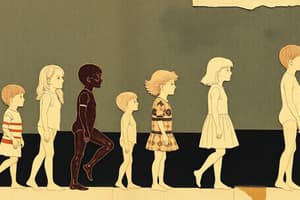Podcast
Questions and Answers
What two primary factors influence physical self-image according to the content?
What two primary factors influence physical self-image according to the content?
- Nutrition and Exercise
- Heredity and Environment (correct)
- Heredity and Technology
- Culture and Media
What does a person's interpretation of beauty primarily depend on?
What does a person's interpretation of beauty primarily depend on?
- Economic status and physical health
- Age and geographic location
- Societal standards and personal experiences (correct)
- Peer influence and education level
Which question is intended to provoke self-reflection about beauty?
Which question is intended to provoke self-reflection about beauty?
- What is beautiful to society?
- What is the historical context of beauty?
- How do you reflect about your own beauty? (correct)
- What are common features of beauty?
Which of the following concepts is NOT mentioned as influencing body image?
Which of the following concepts is NOT mentioned as influencing body image?
Which of these statements best reflects the theme of personal interpretation of beauty?
Which of these statements best reflects the theme of personal interpretation of beauty?
What are two key factors that shape a person's body image?
What are two key factors that shape a person's body image?
Which question encourages a deeper personal exploration of one's perception of beauty?
Which question encourages a deeper personal exploration of one's perception of beauty?
Which of the following is least likely to impact an individual's interpretation of beauty?
Which of the following is least likely to impact an individual's interpretation of beauty?
What underlying theme relates to the concept of beauty in this context?
What underlying theme relates to the concept of beauty in this context?
How can a person's environment influence their self-image?
How can a person's environment influence their self-image?
Flashcards
Heredity's role in body image
Heredity's role in body image
Heredity, or genetic factors, contributes to physical attributes and predispositions, potentially influencing how people perceive their bodies.
Environmental factors impact body image
Environmental factors impact body image
External influences, like media, culture, and societal views on beauty, shape how people see themselves.
Personal interpretation of beauty
Personal interpretation of beauty
Individual perceptions of beauty vary and are influenced by personal preferences and experiences.
Body image reflection
Body image reflection
Signup and view all the flashcards
Beauty standards
Beauty standards
Signup and view all the flashcards
What is heredity?
What is heredity?
Signup and view all the flashcards
How does environment shape body image?
How does environment shape body image?
Signup and view all the flashcards
Body Image
Body Image
Signup and view all the flashcards
What is beauty?
What is beauty?
Signup and view all the flashcards
Reflecting on your own beauty
Reflecting on your own beauty
Signup and view all the flashcards
Study Notes
Physical Self
- Refers to the body, including parts like head, neck, arms, and legs.
- Composed of internal organs (brain, heart, lungs, stomach, intestines, muscles).
- Physical function peaks in early adulthood, declining in infancy and old age.
- Childhood development is slow compared to rapid growth in babyhood. Adolescence is a crucial stage in physical development.
- It's a visible and tangible aspect of a person.
Understanding the Self: Stages of Life
- Pre-natal Period: From conception to birth.
- Infancy: Birth to the end of the second week.
- Babyhood: End of second week to the end of the second year.
- Early Childhood/Preschool Age: Six to twelve years.
- Late Childhood/Elementary Age: Six to ten or twelve years.
- Puberty/Pre-adolescence: Twelve to thirteen or fourteen years.
- Adolescence: Thirteen/fourteen to eighteen years.
- Early Adulthood: Eighteen to forty years.
- Middle Age: Forty to sixty years.
- Old Age/Senescence: Sixty years to death.
The Beginning of Life
- Fertilization: The joining of egg and sperm cells.
- Zygote: The fertilized egg, inheriting hereditary traits from parents.
- Genes: The carriers of hereditary characteristics, including dominant (strong) and recessive (weak).
Factors Affecting Physical Growth and Development
I. Heredity
- The biological process of passing traits from parents to offspring.
- Genes are the basic carriers of hereditary traits, categorized as dominant or recessive.
- Chromosomes (autosomes and gonosomes or sex chromosomes) determine traits.
II. Environment
- Factors influencing physical growth after conception include diet, nutrition, and diseases.
- Learning, experience, and other aspects also play a part.
Body Image
- Refers to how individuals perceive, think about, and feel about their physical appearance.
- Body image can greatly affect physical and psychological well-being.
- Younger women and girls tend to have poorer body image than other groups.
Positive vs. Negative Body Image
- Positive: Acceptance of body shape and size, appreciation for the body's functions, feeling comfortable in one's skin. Healthy relationship with food and exercise.
- Negative: Discomfort with body shape and size, constant comparison to others, engaging in harmful behaviors concerning food/exercise, shame, low-self esteem.
Effects of Poor Body Image
- Depression.
- Low self-esteem.
- Eating disorders.
- Tattooing; piercing; cosmetic surgery.
- Body modifications.
Concepts of Beauty
- Beauty standards vary widely across cultures and time periods.
- Egyptian art depicts slim women with high waists, narrow hips, and long dark hair.
- Some African tribes in the medieval period valued plump women.
Standards of Beauty
- Across cultures, standards of beauty include clean and unblemished skin, thick shiny hair, well-proportioned bodies.
- Beauty is important in all societies and often linked to social advantages.
- Historical examples of concepts of beauty: Renaissance period, and others.
Self-Esteem
- Definition: How highly we value and perceive ourselves, based on opinions and beliefs.
- Impact: Affects decision-making, relationships, emotional health, and overall well-being.
Types of Self-Esteem
- Inflated: Possessing a high regard for oneself at the expense of others.
- High: Having a positive self-regard and contentment in one's own abilities.
- Low: Lack of self-worth, and a diminished trust in one's abilities.
Promoting Physical Image:
- Personal Hygiene: Daily cleaning of the body.
- Good Grooming: Care of face, hair, nails, feet, clothing, and shoes.
- Social Graces: Skills in interacting with people, including introductions, attentive listening, good table manners, eye contact, and body language.
- Proper Bearing and Posture: Maintaining good body alignment.
- Health: A holistic state encompassing physical, mental, and social well-being.
Positive Attitude
- Positive thinking attracts success. Self-esteem comes from what you think of yourself, not what others think.
- Recognize that your body is your own, and focus on its strengths and capabilities, rather than its flaws.
Studying That Suits You
Use AI to generate personalized quizzes and flashcards to suit your learning preferences.
Related Documents
Description
Explore the different physical stages of life, from pre-natal to old age. This quiz covers key aspects of human physical development, including the changes that occur during infancy, childhood, adolescence, and adulthood. Test your knowledge on how these stages impact our physical selves.




